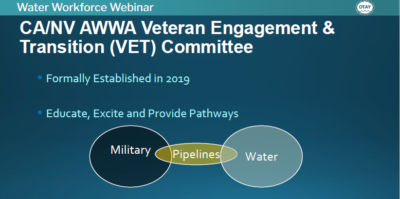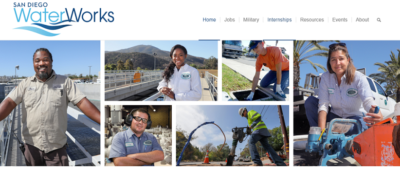The San Diego County Water Authority and its 24 member agencies recognize military veterans for their service and actively recruit vets to fill new career opportunities in the water and wastewater industry. The San Diego County region employs about 4,500 water and wastewater workers, many of whom have successfully transitioned from the military to a new career.
Water and wastewater career day
The Center for Water Studies at Cuyamaca College and San Diego County water agencies are hosting a free career day on January 19, 2022 from 8:30 a.m. – 4 p.m. for veterans looking to transition their careers into the water and wastewater industry. Many water agencies are hiring, and veterans have key skills needed to provide safe, reliable drinking water for San Diego communities.
Veterans will have the opportunity to meet water agency recruiters, learn about pay and benefits, and receive advice on different career pathways and fast-tracked educational opportunities. Registration is online at CenterforWaterStudies.org. The Water Authority is co-sponsoring the in-person event.
A transition to the water world
During a webinar hosted by the Water Authority, Leaders2020, and San Diego Green Drinks in October, Otay Water District General Manager Jose Martinez, a U.S. Navy veteran, spoke about his experience transitioning from the military to the water industry. One challenge Martinez faced was the difference in terminology used between the military and water industries.
As the Vice Chairperson of the American Water Works Association California/Nevada Veteran Engagement and Transition Committee, Martinez discussed the work being carried out to provide direct pipelines and pathways to the water industry. One such pipeline was Assembly Bill 1588, legislation championed by Otay Water District and the Water Authority that passed in 2019. The bill, sponsored by Todd Gloria and Adam Gray, provides experience and education credits toward State water and wastewater certifications.

‘Silver tsunami’ of retirements in water industry
The opportunities for both transitioning servicemembers and local water agencies are significant. More than 30,000 service members separate from the military each year in California, and more than half are transitioning out of active duty in the San Diego region. Roughly half of the current water industry workforce in the San Diego region will be eligible to retire in the next 15 years – and approximately 1,400 water and wastewater industry jobs are expected to open in the region in the next five years.
In October 2020, The Water Authority and its 24 member agencies launched a new website – SanDiegoWaterWorks.org – that provides the first comprehensive posting of regional water and wastewater industry job openings in one location. The San Diego Water Works website includes:
- Current water and wastewater job postings in the San Diego region
- Training and education resources, career advice and internship programs
- Featured jobs that highlight rewarding careers in the water industry
- Information about special training programs and internships for military veterans
- Tips and resources for transitioning military

(Editor’s note: For a story about the successful transition of military veterans to the water and wastewater industry, including a video of a USMC veteran working for the Vallecitos Water District, one of the San Diego County Water Authority’s 24 member agencies that deliver water across the metropolitan San Diego region, go to: waternewsnetwork.com/veterans-serving-public-in-water-industry-careers/)






